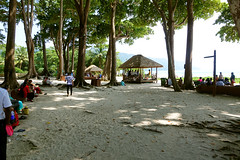If certain hardship is one of the prerequisites to obtain an extraordinary Himalayan view, we were prepared to undertake that on this particular journey. Many a plans had been made to hike the pinnacle of the Karoch Parvat, where the illustrious Kartik Swami Temple is situated. With time on our hands, last month as we were heading towards Kumaon from Rishikesh through the Alaknanda Valley, the decision to hike up the ridge this time was instant.
We left Rudraprayag after lunch and drove to Kanak Chauri, a couple of hours drive on a narrow road. A small pass on the ridge, Kanak Chauri is the base from where the near three-kilometre trail to the Kartik Swami Temple branches off the road. Sunlight streamed down out of a cloudless azure sky as we patiently drove to reach Kanak Chauri, our destination for the day. Climbing steadily from Rudraprayag, we wind down the windows of our vehicle. We were fast getting embraced by the cooler climes of the Himalayas.

Terraced hillside in the Alaknanda Valley. More images from the region at Flickr

A forested hillside near Kanak Chauri. Photo for bNomadic by Sarabjit Lehal. More images at Flickr
We had driven in from the base of the mountains in south-western Garhwal, where the life-sustaining rivers of Yamuna and Ganga begins to sanctify the plains, to the wooded and more austere ranges of central Garhwal. A green cover announces the forest of Kanak Chauri. The settlement was still a couple of kilometres away. A matter of few tea shops and a couple of two-room guest houses, the market of Kanak Chauri (2249m) is located right along the road above its small settlement. Standing aside the road and spangled with sweat, a few girls in cotton salwar kameez, a plain coloured chuuni tied around their wastes and vibrant colourful headscarf, chattered as they filled their over-sized plastic bottles with water through a hand pump. By the time we parked our vehicle and dislodged the luggage, the girls had come again on the road to make a refill. Life is indeed very tough in the hills.

Long walk to education; kids in rural Himalayas might have to walk miles to get education. More images at Flickr

The Kartik Swami Temple atop the forested ridge (right of the frame) above the settlement of Kanak Chauri

The tea shop at Kanak Chauri. Photo for bNomadic by Sarabjit Lehal. More images at Flickr

Hope. Photo for bNomadic by Sarabjit Lehal. More images from the region at Flickr
Before starting from Rudraprayag, we had informed the caretaker at the Mayadeep Holiday Home, one of the very limited options at Kanak Chauri to spend the night. We planned to start the hike for the temple early next morning. As the caretaker prepared the evening meal for us, we took a stroll on the road. The small settlement of Kanak Chauri village along with its terraced fields extends down the valley. From the opposite ridge, the ridge top where the Kartik Swami Temple is situated was clearly visible. Road repair workers were returning from the project sites assigned to them. We too settled inside a wooden hut allotted to us for the night. It was a chilly spring night. The night sky looked clouded. The disinterested caretaker served the evening meal to us inside the hut. We grudgingly ate whatever we needed to and slept in total peace.

The under-construction gateway adjacent to the white temple marks the trailhead of the Kartik Swami Temple
We woke to a beautiful morning. It was dark outside but the twinkling of stars at five in the morning gave us some hope for a clear day. We quickly packed up for the hike and reached the road. Save for a few street dogs, the road wore a deserted look. In complete silence, we started off the climb. The trailhead (2249m) is located just next to a small temple built adjacent to the road. The Kartik Swami is the chief deity of the region. Apart from Shaivites, almost all newly married women from the region; or the ones blessed with a child visit the shrine in reverence and to pay their obeisance to the God. Not only for the religious sentiments it upholds, the temple is a popular vantage point that offer one of the finest views of the western Garhwal Himalayas.

The incipient rays of sun filtering through the dense woods of the jungle. More images at Flickr

The hazy morning view, Rhododendrons, Oaks and the trail. More images from the region at Flickr

Temple bells and bright red chunni tied to a tree branch atop the second ridge crossing. More at Flickr
The trail to the top is fairly broad and passes through a forest mixed with oaks, rhododendrons among many others. The initial stretch of the trail was cemented before it was consumed by the dense forest. With incipient rays of the sun filtering in through the leaves and woods of the jungle, we made a steady progress up the trail. The Himalayan view was still not clear. The rising sun gave us hope as it began to peek over the horizon and painted the sky in marvellous shades of pink and purple. In few minutes, the mighty Chaukhamba imposingly stood above the clouds. The morning sun greeted the snowy peak with pink light. Summits of its neighbouring peaks too shone with the morning sunlight. Far in the distance, the ridgeline including the temple, bathed with the morning pink of the sun.

The Kartik Swami Temple atop the Karoch Parvat shining in the morning sun. Photo for bNomadic by Sarabjit Lehal. Please visit Flickr for more images from the region

The Chaukhamba massif, a prominent peak in the Gangotri group. Artistic capture by Sarabjit Lehal for bNomadic. More images from the region at Flickr

Rhododendrons; most species have brightly coloured flowers which bloom during spring. More at Flickr

The Rhododendron flower is considered edible and enjoyed for its sour taste. More images at Flickr
The trail crosses four ridges to reach the last one atop which the Kartik Swami Temple is situated. The first resting place beneath a rain shed (2435m) is at a distance of 1.6km from the trailhead. Ahead the gradient eases off to reach a small dharamshala as well as the dwelling (2492m) of the temple pujari. The dharamshala here is used by local pilgrims during fairs and festivals in June and November. The residence of the pujari is at a distance of 2.4km from Kanak Chauri. The roofed structure also serves as the emergency shelter for a few pilgrims. The lodging here is limited to only a couple of blankets on the floor of a single door room. The pujari ji gave us chairs to sit and offered us tea. He was just getting ready to undertake the morning rituals at the temple.

The dharamshala-cum-pujari’s abode before the steep hike begins. Carry enough water or supplies for the hike as there is no source of water anywhere near the trail. You can, however, procure some water from this place

Just before the Bhairon Nath shrine. Photo by Sarabjit Lehal. More images at Flickr

With the Kartik Swami Temple in the background, the Bhairon Nath Temple marks the start of the final stairs

The idol of Bhairon Nath. Photo: Sarabjit Lehal

Just before the final set of stairs to reach the top of the narrow ridge. Photo by Sarabjit Lehal. More at Flickr

The workers were securing the platform and renovating the stairs; the Kartik Swami Temple on the top

The ridge pinnacle against the backdrop of the mighty Chaukhamba; the hazy weather continued to disappoint us. Photo for bNomadic by Sarabjit Lehal. More images at Flickr

The iron railings that cordoned the platform and stairs were loose and were being secured. More at Flickr
The administration had engaged a few workers to cement the pathway to the top of the temple from the pujari’s abode. The initial temple dedicated to Bhairon Nath (2570m) is located at a distance of 600m from here. Although, we were able to locate the snowy peaks but the overall Himalayan view was not as clear. We continued our steep ascent on a stony pathway. This last section of the pathway was steeper than the rest. Huffing and puffing, in a few minutes we were at the top. From Bhairon Nath temple, the top is hardly at a distance of 60m. The workers were busy patching up final set of staircase just below the main temple. The temple is built on a secured platform at 2589m.
We were unlucky because the view was hazy. Down below in the valley forests, the forest fire was already contributing to the after spring haze in the weather. The crest was windy. We could see moisture laden grey clouds closing in from south west direction. Awestruck, we thought how the view would be on a clear weather day. I occupied myself with taking travel notes as Sarabjit got himself busy with making photographs. The inside layering of my windcheater jacket was drenched with sweat, even as it was cold outside. The platform on which I was sitting in the courtyard of the temple is perched precariously on a narrow ridge with sheer drop of a few thousand metres on three sides. Tens of temple bells were hung on iron bars, meant for the purpose, by devotees who sought the deity’s blessings.

The Kartik Swami Temple and the mighty Himalayas. Photo for bNomadic by Sarabjit Lehal. More at Flickr

The Kartik Swami Temple perched precariously on a narrow ridge with sheer drop of a few thousand metres on three sides. Photo for bNomadic by Sarabjit Lehal. More images at Flickr

A natural representation of Kartik Swami Ji, also known as Kartik Murugan Swami in the southern part of India

The Ganesha; legend has it that Kartikeya, the son of Shiva and Parvati, came here to sulk after his brother Ganesha had been granted superimacy. Photo for bNomadic by Sarabjit Lehal. More at Flickr
From the Kartik Swami Temple, there is a perfect view of the Gangotri, Kedarnath and the Chaukhamba peaks and also towards the Badrinath direction. The peaks of Kedarnath seem to be precipices almost perpendicular, no snow finding a resting a place on their grey sides. The Chaukhamba peak appears like the crater of an extinct volcano with walls still standing and hollow inside; that facing the south is the smallest and lowest. Apart from the wind, the only sound that breaks the silence is that of fluttering prayer flags. The brightly coloured temple houses an ancient stone image of Kartik Swamy, the elder son of Lord Shiva. Legend has it that Kartikeya, the son of Shiva and Parvati, came here to sulk after his brother Ganesha had been granted superiority. Subsequently, Kartikeya sacrificed his body and gave his bones to Lord Shiva as a testimony of his devotion to his father. Lord Kartik Swami is also known as Kartik Murugan Swami in the southern part of India.

The narrow ridge which is exposed on both sides. More images from the region at Flickr

The dharamshala from the top. Photo for bNomadic by Sarabjit Lehal. More images at Flickr
It was on descent, when I realised that iron railings which cordoned the platform and stairs were loose and needed repairs. Right up to the Bhairon Nath temple, the ridge was very narrow and exposed on both sides. On our way down we came across many newly wedded women attired in sari who were going to the temple to pay homage to their revered deity and seek blessings. We sat under the rain shed and gobbled up a kg of grapes we had bought from Rudraprayag yesterday. And what a gratifying morning meal it was! Built at a ridge crossing, the rain shelter is at a picturesque vantage point that affords great views of the hills and step farms going down to the valley floor towards south. To the north stood the imposing Chaukhamba, which was now hidden behind grey clouds.
The temple is at a distance of 3.1km from the trailhead and with two litres of water and a kilogram of grapes, we had happily completed our morning hike.

View southwards from the rain shelter. Please visit Flickr for more images from the region

Just above the settlement of Kanak Chauri; the market, the road, Mayadeep and our vehicle parked on the road

Terraced fields near Mohankhal (2144m). Photo for bNomadic by Sarabjit Lehal. More at Flickr

Pokhari (1901m); the connect between Rudraprayag and Karanprayag or Gopeshwar via Pokhari offers an alternate route
Getting There
The temple of Kartik Swami is three km on a broad trail from the base at Kanak Chauri which is 40km from Rudraprayag on the narrow Rudraprayag – Pokhari road. Another approach can be from Karanprayag; reaching Pokhari first.
Average Altitude: 2200m
Best time to visit: Autumn and spring; avoid monsoons
Travel Lure: Himalayan views and natural heritage
Accommodation: Limited; confirm in advance
 bNomadic
bNomadic











Lovely post. We have a homestay in the village of Guniyala, just a km before pokhari market, as you drive in from Mohankhal. Kartikswamy is such a magical place, and such a lovely hike. Check out The Birdsong Cottage, on Fb, that is my place.
Thanks for dropping by the blog Kiran! Glad you liked it. We plan to be back soon in your region. Staying at Guniyala would be an awesome experience. I remember crossing it. Looking forward to visiting you sometime soon. 🙂
Keep visiting bNomadic for more such travel stories.
Lovely and detailed write up. Kartik swamy is on my mind for last few years. Hope to visit soon. ☺
Thanks Arv! Glad you liked it. Must visit. Keep visiting bNomadic for more such travel stories 🙂 😊
Sure I will. Happy to have come across this write up 🙂
I missed so much on your blog 😉 .. lovely article but then you write so well. I love love love the Chaukhamba monochrome and the child’s photograph.
Even I need to visit Kiran’s Birdsong Cottage some day soon. 🙂
🙂 Thanks for showering bNomadic with your love, support and appreciation. As I said, we were unlucky on that particular day mostly because of the haze and weather. Will be there soon. The Birdsong Cottage actually deserves a visit. I wasn’t aware about this place earlier.
Kiran is a good friend. It would be good if travelers like you support other enthusiasts.
O I didn’t know this. Her property is just at the right spot. Will visit it next time and talk about it on bNomadic.
Fantastic.